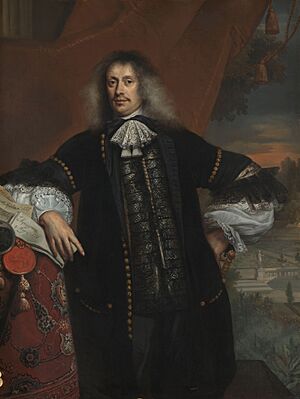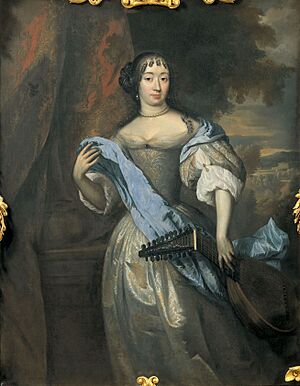Hieronymus van Beverningh facts for kids
Hieronymus van Beverningh (born April 25, 1614, in Gouda – died October 30, 1690, in Oud Teylingen) was a very important person in the Dutch Republic during the Dutch Golden Age. He was a powerful politician, a skilled diplomat (someone who deals with other countries), and even loved plants, becoming an amateur botanist. He also supported artists and scientists.
Contents
A Look at Hieronymus van Beverningh's Life
Early Years and Education
Hieronymus van Beverningh was born into a family with a military background. His father, Melchior Beverningh, was a captain in the Dutch army. His grandfather was a high-ranking officer in the artillery.
Hieronymus went to school in his hometown of Gouda. Later, he studied at the University of Leiden, which is a famous university in the Netherlands. After his studies, like many young gentlemen of his time, he traveled through France. This was called a "grand tour." On April 4, 1655, he married Johanna le Gillon, but they did not have any children.
Starting a Political Career
Hieronymus quickly became involved in politics in Gouda. In 1645, he joined the city council, known as the vroedschap, and was elected as a schepen, which was like a city magistrate or alderman. The very next year, he was chosen to represent his province, Holland, in the `States of Holland and West Friesland`. This was the main governing body of the province.
In 1651, he represented Holland in a big meeting called the Groote Vergadering. This meeting led to a period where the Dutch Republic did not have a main leader, or "stadtholder." In 1653, Hieronymus became a member of the `States-General of the Netherlands`, which was the national government of the Dutch Republic. He became very good friends and allies with Johan de Witt, who was the most powerful politician in Holland at the time.
Peace and Secret Deals
Hieronymus van Beverningh played a key role in ending the First Anglo-Dutch War. In 1653, he was sent to England as a special negotiator, called a plenipotentiary, along with other Dutch representatives. Their job was to make a peace treaty.
The negotiations were tricky. England wanted the young Prince William III (who was only three years old) to be kept out of important jobs like "stadtholder" and "Captain-General." These were jobs his father and ancestors had held. Johan de Witt and his political group in Holland were okay with this idea. However, they knew the other Dutch provinces would see it as England interfering too much.
To solve this, De Witt and Beverningh made a secret plan. Beverningh secretly negotiated with Oliver Cromwell, the leader of England, without telling the representatives from the other Dutch provinces. They agreed to a secret part of the treaty, called the Act of Seclusion. This Act said that the province of Holland would never appoint William as stadtholder and would prevent him from getting high federal jobs.
The States of Holland secretly agreed to this Act. However, a clerk working for De Witt leaked the secret. The province of Friesland demanded an investigation. De Witt, being very clever with words, sent instructions to Beverningh in a secret code. He also sent a regular letter warning Beverningh. This allowed Beverningh to quickly give the secret Act to Cromwell before the Dutch delegation could decipher their instructions. This made it a done deal.
This caused a big scandal, but it eventually calmed down. Still, it delayed Beverningh's appointment as the main treasurer of the Dutch Republic until 1657.
Important Diplomatic Missions
Besides being the Treasurer, a job he held until 1665, Beverningh often went on important diplomatic missions for the Dutch Republic. He was involved in many major peace talks:
- In 1665, he negotiated an alliance during the Second Anglo-Dutch War.
- In 1667, he led the Dutch team that negotiated the Treaty of Breda (1667), which ended that war with England.
- In 1668, he helped create the Triple Alliance (1668) and the Treaty of Aix-la-Chapelle (1668).
- In 1674, he led the Dutch delegation that negotiated the Treaty of Westminster (1674), ending the Third Anglo-Dutch War.
- Finally, in 1678, he helped negotiate the Treaty of Nijmegen, which ended the Franco-Dutch War.
During these years, he also became the schout (like a sheriff) and later the burgemeester (mayor) of his hometown, Gouda. In 1672, a terrible year for the Netherlands known as the Rampjaar (Year of Disaster), he worked closely with William III during the war against France. When William III became stadtholder, Beverningh quickly supported the new leader, even though he had been a strong supporter of the previous government.
Later Life and Love for Plants
After negotiating a trade agreement with Sweden in 1679, Hieronymus van Beverningh retired from public life. He had been appointed a leader of Leiden University in 1673. In his later years, he focused on science, especially botany (the study of plants). He became so well-known that even the famous scientist Carl Linnaeus gave him credit for discovering a type of nasturtium flower.
Beverningh had a special botanical garden at his estate called Oud-Teylingen, near Leiden. This garden had many rare plants. It even inspired a German botanist, Jacobus Breynius, to write a book about rare plants in Dutch gardens, which he dedicated to Beverningh.
Hieronymus also acted as a maecenas, which means he was a patron who supported artists and scientists. He helped finance a trip for the botanist Paul Hermann to Ceylon (now Sri Lanka). This trip led to an important book about orchids. He also helped pay for the purchase of a large library for the Leiden University Library.
While helping to organize this library, Beverningh fell ill after falling off a ladder. He died at his estate in October 1690. He was buried in a tomb he had bought in the Janskerk (Gouda) in Gouda.
Images for kids





